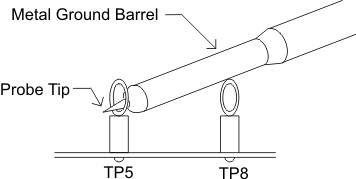SLVU358A February 2010 – January 2022 TPS51513
4.1 Test Equipment
Voltage Source: The input voltage source, VIN, must be a 0-V to 14-V variable DC source capable of supplying 10 ADC. Connect VIN to J1 as shown in Figure 4-2.
Multimeters: A 0-V to 14-V voltmeter (V1) must be used to measure VIN at TP1 (VIN) and TP2 (GND). A 0-V to 5-V voltmeter (V2) is necessary for VOUT measurement at TP5 (VOUT) and TP8 (GND). A 0-A to 10-A current meter (A1) as shown in Figure 4-2 is used for input current measurements.
Output Load: The output load must be an electronic constant resistance mode load capable of 0 ADC to 30 ADC at 1.05 V.
Oscilloscope: A digital or analog oscilloscope can be used to measure the output ripple. The oscilloscope must be set for the following:
- 1-MΩ impedance
- 20-MHz bandwidth
- AC coupling
- 2-µs/division horizontal resolution
- 20-mV/division vertical resolution
Test points TP5 and TP8 can be used to measure the output ripple voltage by placing the oscilloscope probe tip through TP5 and holding the ground barrel TP8 as shown in Figure 4-1. Do not use a leaded ground connection as this may induce additional noise due to the large ground loop.
 Figure 4-1 Tip and Barrel
Measurement for VOUT Ripple
Figure 4-1 Tip and Barrel
Measurement for VOUT RippleFan: Some of the components in this EVM may get hot and approach temperatures of 60°C during operation. A small fan capable of 200 LFM–400 LFM is recommended to reduce component temperatures while the EVM is operating. The EVM must not be probed if the fan is not running.
Recommended Wire Gauge: For VIN to J1 (12-V input) the recommended wire size is AWG 14 per input connection, with the total length of wire less than four feet (2-foot input, 2-foot return). For J2, J3 to LOAD, the minimum recommended wire size is 2× AWG 14, with the total length of wire less than four feet (2-foot output, 2-foot return)